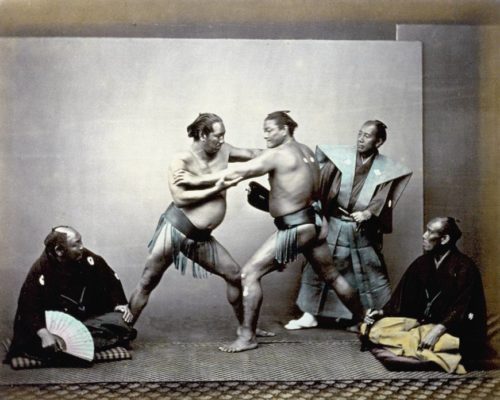
Claudio Parmiggiani
“The rich have grown afraid of screens. They want their children to play with blocks, and tech-free private schools are booming. Humans are more expensive, and rich people are willing and able to pay for them. Conspicuous human interaction — living without a phone for a day, quitting social networks and not answering email — has become a status symbol. All of this has led to a curious new reality: Human contact is becoming a luxury good. As more screens appear in the lives of the poor, screens are disappearing from the lives of the rich. The richer you are, the more you spend to be offscreen. Milton Pedraza, the chief executive of the Luxury Institute, advises companies on how the wealthiest want to live and spend, and what he has found is that the wealthy want to spend on anything human. ‘What we are seeing now is the luxurification of human engagement’.”
Nellie Bowles (N.Y. Times, Human Contact is now a Luxury Good, March 23, 2019)
“This subaltern perspective allows us to glimpse something of extreme importance: information emerges in the footprint of the value-form and is an extension of its functionality. Computation, it will be shown, turns out to be financialization by other means. Communication, or what Charles Sanders Peirce calls “joint-acting,” is the raw material of both. This linking of communication to computation by means of information and financialization poses an urgent question for these times: If everyday communication results in the everyday murder of subalterns, how do we send a different message?”
Jonathan Beller (The Message Is Murder: Substrates of Computational Capital)
“Humans leave their mark, and the earth carries it forward as an archive.”
Jussi Parikka (A Geology of Media)
“But still – and I say this in a whispering and shaking voice, so that no one may betray this secret – even in such deep Hell, a slight glimmer of hope shines. In such Hell I am all-powerful. My Will is God. I am God. As I cry such a cry of the highest pride, the echo resonates: I am God. And this echo, which is nothing but a faithful repetition of my pride, has a demolishing effect upon my mind. Listen attentively to what is happening: I am God and God is me. The sciences and philosophies teach that I am God. The arts prove experientially that I am God. Yoga demonstrates experientially that I am God. Therefore, I know that I am God. And that is why I am in this solitary cell that I created for myself.”
Vilem Flusser (The History of the Devil)
Recently (April 15th actually) Mike Pompeo gave a speech at Texas A&M University. During the speech he said.. “What’s the cadet motto at West Point? You will not lie, cheat, or steal, or tolerate those who do. I was the CIA director. We lied, we cheated, we stole. It’s — it was like — we had entire training courses. It reminds you of the glory of the American experiment.” —
The audience applauded and laughed. THAT was the interesting part. And it is that sort of response, which one finds repeatedly in the U.S. today, that is worth trying to understand. The first part is just the deep desire for consensus in American culture. Agreement is seen as mature, and it is encouraged from first grade onward. It is of course also the latent aggression and rage in American society. But there is also something else going on, and it is a deflected kind of thought structure — and it runs alongside a growing fascistic background practice. I will get to the fascist part below, but this less obvious and very insidious cultic thought process is growing. It is able to grow (and has grown quickly) because of the erosion of literacy and basic skills in logic and reason. And that loss goes hand in hand with computational thinking. And as I will write more on the aesthetic codes at work, Mike Pompeo’s tie is worth a note in passing. It was exceptionally and weirdly long. Longer even than Trump wears them. This, none of this, the remarks, the tie, none of it was accidental or incidental. The tie is its own kind of sadism. The ‘splash back’ length suggests both vulgarity and contempt for others, for those in close proximity.

Kadar Attia
But this cultic and perhaps often unconscious wish or dream work is aligned with the authoritarian sensibility. Laughter shared with Mike Pompeo was both anxious and nervous but also a kind of passive/aggressive sadistic impulse. And the clues to this cultic thinking can be found in style codes and an aesthetics of primitivism and mock innocence. The innocence masquerades as naivety often, but often as retro nostalgic volkish symbology. And there is now an aspect of this cultic thought that works through the appropriation of environmental concerns and activism. Just as the very rich can now afford an kitsch elysian fields cum new age pastoralism, a return to “human engagement” even if those humans are slaves, essentially, the green consensus for the bourgeoisie is one in which the cultic surfaces in near hysterical registers of alarm and stigmatizing. I wrote last time about the allure of end-times thinking, and while that remains true there is another level operating in which diverse and often contradictory messages and fantasies are being activated. The sadistic pleasure of demanding people stop reproducing for example, or to stigmatize nearly every single activity the average working class person has to engage in to survive is the voice of the overlord, the voice of the man on horseback looking down at *his* chain gang (or hers). And there is a knee jerk admission, or rather confession, that the overlord is guilty too. Guilty but still privileged somehow. Confession is a luxury. The riff-raff sit mesmerized by their smart phones, texting compulsively, but the elite buy protection from screens.
“Americans today — maybe not you, enough of them — see luxuries as false necessities, even while they can’t afford, and don’t think people should have real necessities. But that’s precisely the capitalist illogic they’ve been trained and conditioned to obey. Enough of them really believe that bizarre upside thinking to make plastic surgery normal, to make Instagram envy real, for their kids to demand the right “brands” or they’ll be bullied, to feel they need to drive the “right” cars and live in the “right” homes or else they won’t be respected. To make life a constant and endless and relentless battle of status competition for luxuries that are false necessities — while everybody seems to overlook the grim reality that nobody much can afford real necessities anymore. But these two things aren’t a coincidence — the latter is the inescapable consequence of the former.”
Umair Haque (Medium, 2019)

Simon Callery
Stigmatizing the survival activities of the working class is the fascist imprint that is now nicely groomed with “responsible” green behaviour, a behaviour that is mostly just absence of things.
“FASCIST PRAXIS is CHARACTERISTICALLY, though NOT NECESSARILY and NOT INVARIABLY, accompanied by certain ideological motifs which represent a flavor of or code within the general diverse liberal cultural ideological output but which have certain identifiable tendencies: a. irrationalism b. anti-intellectualism in both senses (Heideggerian suspicion of cognition and intellect, and hatred of the educated) c. racism and other pseudoscientific mythologies to hierarchize and debase humanity d. nationalism and tribalism e. violent masculism. Antisemitism as an extreme type of mystical anti-liberalism g. misogynist racist phallocratic somatophobia h. the class based proliferation of amoral individualism (Nieztsche for the elites, solipsistic “storytelling”) and intensification of homogenizing repressive norms for hoi polloi (hijab hysteria, outsider-demonizing, Gates led sterilizations, etc).”
Molly Klein (Velociraptora Antediluvianovna Prelapsarianov, twitter record)

Helga Paris, photography. (Halle, East Germany).
One of the things Beller is building toward is, in a sense, an aspect of what I am calling this new cultic thought.
“Self-alienation from nature produces both the human and nature—an “originary” binary that in truth can only be imposed retroactively as the result of alienation. This alienation is, for the early Marx “objective man,” and as Sean Cubitt has brilliantly shown, it constitutes the environment as an externality of capitalism and colonialism that, in a second moment, even when re-deployed by environmentalists for protection and saving, continues to presuppose capitalism and colonialism in the very notion of “the environment” precisely because the environment is conceived as an externality. The conditions under which the environment is an externality are consequent from colonization—in the longue durée, the practical continuation of the severance of man (“man”) from nature (“nature”). Thus any invocation of “the environment,” presupposes it as a colonial externality. The notion itself, despite the best intentions of some, results and persists from the unchecked proliferation of narratives by abstractions embedded in the material operations of political economy broadly conceived—abstractions that are themselves part of systemic colonization of the planet and the mind by capital.”

Ulrich Erben
Capitalist alienation is a specific alienation; one that is both built with strands borrowed from positivism, behaviorism, and financialization. Or rather, positivism and behaviorism and financialization are themselves built from capitalist alientation. For tracing back one finds private property and the process that would lead to the formation of hierarchies, and finally, unpaid labor. That was Marx’s insight (per Beller). All the valuing of Nature, or of anything, is really a subjective numbering. Nothing is itself of any value to capital.
The digital is another stage of the Spectacle, per Debord (who Beller also quotes at length) — it is not something outside capital. It is capital. And the green movement is entangled in this inscription of capital on the world. If Adorno thought we might escape by aesthetics, art, by what he called *the more* of art (and this is why success of failure meant nothing to him and were viewed as the terms of the philistine) it was because the artwork, partly by virtue of its uselessness, could both recuperate the primitive, the myth, while overcoming it in a sense, by a unity of disunity. But more to the point here is that the logic of the overlords, of slavery and servitude, is alive in the kitsch (well meaning) expressions of concern and outrage about pollution and climate change. All such fetishized subjectivities about Nature are impossibly tied into the history of conquest and domination. Nature (second nature) cannot be separated from domination. And for the capitalist all concern is false concern. All concern (even if believed to be sincere…and as Kierkegaard said, we never know when we are being sincere) is a kind of policing. And that policing tendency is something that today is of inordinate magnitude. Green concern is, for the moment, a police action at heart.
But this is being, in one way, too general. It is not that everything is capital. That sentence has no meaning per se. Nature, as Adorno wrote, is really second nature. This was talked about last blog post. Real first nature (if you will) is mythic, to imagine it is like trying to imagine a world without repression. All we know is the second nature.

Maxime du Camp, photography. 1850.
Beller again….” When our very language has been conscripted as a means of capitalist production and reproduction, when it is expropriated and recoded by content indifferent management, the difficulty and perhaps impossibility of making the second externality count is effected to the point of exclusion and these outsides become accessible only by what might be figured as an anti-racial-capitalist, decolonial feminist-queer poetics and politics, where intellection, engaged in active self-decolonization endeavors to neither presuppose nor conform to programs of capitalist conscription.”
This is both right, but not right, too . The correct part is about the conscripted language of everyday use. And here, too, the overpopulation meme is described perfectly…..“…femicide and disposable life, which is of value only in as much as it is of no account. These realms of no account are the realms of the innumerable— the environment itself, the place where waste can be dumped, people can be starved, raped, harvested and murdered, oceans and atmospheres the internet of value, by karl marx . polluted, all with impunity, all without being held to account. These externalities in the form of lands, animals, peoples, ecologies, experiences, histories, cultures, genocides, fireflies are included as excluded in capital’s conscription of systems of representation.” The perhaps not right part are critiques outside capital conscription. Here is where art might enter the discussion.

Christina Demiddle, photography.
The innumerable are just numbers on spread sheets, are algorithms and data. I mean most of the lay public love to recite numbers when talking about end times. The environment becomes numbers. And this is partly why militarism is hard for such people to place front and center. The military is not JUST numbers. Militarism is infused with a fantasies of sado/masochism, and no doubt a dozen other things, but the point being that the military (with all the repression that is lodged in, just say, the uniform) is always something more. Much as the uniformed police officer is always something more.
Data and information are the result of capital. They are a kind of expressions of capital. Last post I talked about John Rawls, and how the everyday object of utility (real or not) is like looking at or handling the mind of John Rawls. But even Rawls is, of course, an historical result. So is Ayn Rand.

Lucien Freud
I wonder if these shrinking screens do not symbolize the shrinking vista of the imagination. Does not this pseudo miniaturization reflect the economic shifts of global capital — as a personal myth, but as the bourgeoisie more and more self-restrict, voluntarily submit to various new laws and a shrinking of civil liberties, they are like the falling rate of profit in a way. Consolidation …big screen to small. Small to tiny. Increasingly portable. In fact the tiny screen is never meant to leave the body of the owner. The screen eventually becomes so small you cannot see it. You are the screen, then.
But this portability is assigned a role in a system that increasingly restricts mobility. Just as Beller describes ‘distribution of dispossession’. New technologies, said McLuhan, … “because of the invisibility of any environment during the period of its innovation, man is only consciously aware of the environment that has preceded it; in other words, an environment becomes fully visible only when it has been superseded by a new environment; thus we are always one step behind in our view of the world.” I am not sure this is true, at all actually, but it is interesting and rather relevant anyway. For it implies this quality of lateness (something Lacan obsessed about) and of the importance of an elsewhere.Capitalism creates a sense of having always missed the most important appointment. Our psyches are structured, increasingly, like Capital.
“The iDevice is enabled by dubious labor practices, including child labor in the mines of Congo; the appalling working conditions, which lead to a number of suicides, in the Foxconn factories in China; and the planned obsolescence designed into the product, which also contributes to its weighty share of electronic waste problems. To make game play out of such themes is to look at the darker, not-so-immaterial cultural techniques that sustain creative cultures of digitality. As noted in Nick Dyer-Witheford and Greig de Peuter’s Games of Empire, Molleindustria games effectively establish procedural critique, a mapping of the algorithmic logic into which you, as the player–subject, are sucked into a systematic production of a limited, repetitive, depressive, and oppressive world without an outside.”
Jussi Parikka (ibid)

Fadilah Karim
Now in Cinematic Mode of Production (his first book) Beller suggested (mostly) that psychoanalysis was just cinema. And in a sense this is true, but only if one qualifies that statement by saying all cinema is merely psychoanalysis. Both naturalize each other.
Now within the environmental discourse there lies an only partially hidden trope of return. There is the unavoidable fantasy of an Edenic past in all thinking on second nature. A history must be invented and then retroactively inscribed on dreams of change and correction. And the environmental discourse is so important because, firstly, there IS an environmental crises. But the narration of this crises is failing, and the front edge of failure is seen in programs to save Capitalism.

London fire fighter wearing smoke helmet, 1908.
And this interior world is almost like the second nature of the second nature.
“For some in the media, “archaeology” has come to supplant basic history, replacing it with a form of material retrieval—as if the preservation of materiality was tantamount to preserving history itself. This has led to an archaeology (really more a mere cataloging) of the apparatus itself, rather than an investigation of the scenes in which the apparatus found its way into the spheres of research and experience.”
Siegfried Zielinski (Deep Time of the Media)

Alex Colville
So, back to the cultic and to the photograph. And I want to reach into Beller, again. For one of the compelling and infuriating qualities of Beller, in equal measure, is that he is both literal and metaphoric, or symbolic. Or allegorical. I think he thinks he is literal. And the reason this is so compelling is because it asks one, the reader, to interrogate the idea of whether metaphor is literal, or if allegory is not all that there is today. Or ever was. Or if allegory has disappeared, like the dinosaur and dodo. Now, this very popular meme *6th great extinction* suggests a subject position outside Nature. The viewer of the apocalypse. Which takes place on a screen. So much science fiction film over the last thirty years has taken place with increased attention to screens. Or, characters looking out windows of the spacecraft or research station or whatever. *Outside* is a threat. Outside is the global south in a way, or black neighborhoods in the US. In poverty stricken American cities.
“With respect to practices of looking, there is a deep-seated dialectic, if you will, between racism and photography.”
Jonathan Beller (ibid)
There is a need to make clear that there is a distinction …though not nearly a total or absolute one…between the socio historical and social violences, of certain specific photographs, and the more general consideration of the apparatus itself and photography itself. But it is Beller’s belief (and he cites the great Jonathan Crary here) that one cannot talk of American modernity, the manufacture of American modern individuality and custom and ideology without recourse to the emergent properties of photography and racism. Or rather, there is no photography per se without racial constructs.

Reichsmusiktage, 1938. Nazi degenerate music exhibition poster.
“If the making of whiteness and blackness is mediated by the dynamics of photography, then the reverse is also true: the making of photography is mediated by the dynamics of whiteness and blackness. Photography does not evolve in a vacuum; it is, to borrow from Stephen Heath, a dispositif, the social and technical as photography. Thus we may expect to find that “race relations”—that is to say, forms of racism—may be not only at the heart of “the meaning of sight” but inscribed in the technological platforms that enable sight and, therefore, in ‘photography itself.'”
Beller (ibid)
At first glance (sic) this seems a perhaps odd if not unlikely proposition. However, the period of optical discovery is important for the primacy of colonial logic and belief, and of Capital and science. The rise of eugenics and of psychoanalysis…and detective fiction for that matter.
“Did photography abstract racial and capitalist encodings in a manner consonant with what we have seen thus far with informatics and with the cinema? And if so, what does this
prejudice of technology teach us about the organization of appearance, semiosis, and the terrain of communication?”
Beller (ibid)

Jean-Michel Basquiat
And then Beller adds….“Thus it seems to me that something deeply hidden, repressed, or unthought inheres in the dispositif that is photographic technology.” And perhaps it is impossible to disentangle the forces that drove the development of photography. The early techniques each came out of a different social context; Collodian papers, the Albumen process, Cyanotypes and Salted Papers. The Van Dyke brownprint and Gum Prints…all of these were used in the late 1800s. And its astonishing, as an aside, how many of these early photos survive. But there is a profound difference in aesthetics and in the make-up of the ideal viewer. ( Photographer Robert Burley traveled the world to photograph the death of film labs. Kodak now makes only five or six kinds of film where thirty years ago they made three hundred. See his book The Death of Darkness, 2012)
“White psychology and white visuality rests atop black dispossession. The camera itself would be studied as a machine for the generation of what Saidiya Hartman calls scenes of subjection—forms of domination that go undetected.”
Beller (ibid)
The construction of white visuality is layered across all the techniques, but it is still difficult to fully delineate what is at work in Platinum Palladian photographs and, say, silver nitrate prints. Or Hasselblad images from Leica images or Rolliflex or Graflex. My early love of photography came through a bartender my family knew who came by one day with a camera and set of lenses…a Nikon, that some guy had left at his bar. My father bought it on the spot and gave it to me. God I loved that camera. Anyway, I digress. There is no question, I don’t think, that Beller is basically correct. But he also raises many questions, more than he answers actually.

Henri Cartier Bresson with Leica.
Allow me one more longer quote from Beller, for this gets more to the heart of the matter.
“The machine as a racial formation is also a machine of racialization. These procedures would include the institutionalization of photography in various disciplines, the elaboration of
a racial imaginary by photographic and other means as well as a critique of assumptions about the ontology of photography. Vicente Rafeal’s work on census photography in the colonial Philippines as a technology of racialization comes to mind here, as does the work of Malek Alloula, Jane Gaines, and bell hooks. Each of the three latter writers explores the imbrication of photography in regimes of racist violence. ( ) Given the racializing role of the census, we see that Sebastian Franklin’s research on Herman Hollerith, the inventor of the punchcard and enabler of first the broad based, searchable data collection of the national census (and later IBM’s infrastructural support of the Holocaust), turns up something arresting.“Hollerith utilizes an extended analogy between data collection, on the one hand, and interpretation, the objective conditions of society, and photography on the other, noting that ‘the enumeration of a census corresponds with the exposure of the plate in photography while the compilation of a census corresponds with the development of the photographic plate’.” The census and the photograph were media of racialization. The image was data visualization.”
Now, I think this relates, actually, to this idea of a cultic thought process and a contemporary culture of agreement — but it is connected not just to the failed narrations of Nature and extinction (failed as prophetic narratives, irrespective of being correct or not) but also to the rise of a fascist praxis and a growing class of sort of Vichy ready petit bourgeois white liberal Americans. Educated, at least mostly, and increasingly surrendering to the fascist tide of immovable hierarchical class boundaries. The narratives seem to reproduce broken promises over and over and over. And here there is a fascinating discussion to be had about the predictive as a feature of instrumental thinking.

Emma Kunz
In 1778 James Hutton, a wealthy Scots amateur scientist and geologist published a thousand page treatise titled The History of the Earth. And he illustrated it. The importance of this book is in how it changed the ideas of how to visualize nature. And how to think about it. Stephen Jay Gould said that this idea of deep geological time is impossible to grasp except as metaphor. And I mention this because one of the problems with the new cultic thought is that it allows for no metaphor. For instrumental reason has led now, at the birth of the 21st century, not to deeper levels of understanding, or richer aesthetic expressions of life and death, but kistch versions of everything.
“Rudi Visker used the term “anarchéologie” more than ten years ago to describe a method that evades the potential of identifying a “standardized object of an original experience.” A
history that entails envisioning, listening, and the art of combining by using technical devices, which privileges a sense of their multifarious possibilities over their realities in the form of products, cannot be written with avantgardist pretensions or with a mindset of leading the way. Such a history must reserve the option to gallop off at a tangent, to be wildly enthusiastic, and, at the same time, to criticize what needs to be criticized. This method describes a pattern of searching, and delights in any gifts of true surprises. In his critique of Hitler’s brand of fascism, Bertolt Brecht frequently pointed out that order is a sign of lack, not of abundance.”
Siegfried Zielinski (ibid)
Kitsch science is that which embraces a superficial order and organization of data without questioning not just the truth of verifiability of any particular item, but also the structure. I remember the joy of wandering old massive book stores (The old Strand in NYC for one, but several on Telegraph Ave. in Berkeley, and many on Tottenham Court Rd in London) where I could spend whole days getting lost and discovering books I had never heard of. Today one orders book online, and searching for the unknown is ever harder. Finding that which you don’t know about is near impossible today. Zielinski quotes Wittgenstein, too, on possibility. Wittgenstein, like Musil, saw the primary error of western philosophy residing in the belief that possibility was a “a shadow of reality”. Zielinski also notes that there was a shift in attention toward media, or at least to the word *media*, and researchers, hard scientists, sociologists, all of these disciplines sought funding by emphasizing their concern with media, and a bit later digital media, and the internet. But it was all driven by the profit motive. And that is always looming over all things. And hence the proposals were organized and repetitive and unimaginative. The authors of this research may not have thought that, but now some twenty years later the proof is that this stuff mostly led nowhere.

Mark Broyer, photography (Hamburg, Germany)
“Today Kairos and Kronos are reversed: we construct buildings that will be ruins in a few decades, or even years, and then demolished; what has become chronic now is fun, which has nothing to do with joy, for fun does not require a reason or an occasion.”
Siegfried Zielinski (ibid)
Erwin Schrödinger said that knowing too much was never the problem, but rather believing you know more than you do. (I paraphrase). It is a bit like the old chestnut ‘a little knowledge is a dangerous thing’. And I think this marks part of the new cultic, which is a form of hubris and narcissism, among other things. Hollywood is, of course, a perfect example of this belief in superficial order and predictability. And as an aside; Game of Thrones is an exercise in emptiness. A product made by damaged children, a kitsch version of Wagnerian cliff notes. It marks a new level of infantilism, in fact, and is hugely embarrassing to watch. But I digress.
“We look back along the wall: could we not pull it down, has it always been there? As we scan its windings over hills and vales back in history we behold a land far, far, away at a space of over two thousand years back, where the wall flattens and disappears and the path was not yet split, but was only one. Some of us deem it worth while to walk back and see what can be learnt from the alluring primeval unity.”
Erwin Schrödinger (Earth and the Gods, 1954)

John Rocque’s plan for Richmond Gardens, 1766.
Beller makes a point that is important, when he discusses Barthes essay on photography. Putting aside the wider critique, Beller mentions Avedon’s photograph: ‘William Casby, Born a Slave’. It is important because Barthes concludes his discussion of the photo this way…. “the essence of slavery is here laid bare: the mask is the meaning, insofar as it is absolutely pure.”
Let me quote Beller…
“Ironically, to lay bare the essence of slavery, the photograph and therefore Barthes must be in “mask” mode—that is, on the side of meaning and of society, of semiotics. This “essence of slavery” is neither named nor described. Rather, its meaning conveniently dispensed with, the photograph opens the way for further (aesthetic) remarks on the inherent characteristics of the photographic medium. One suddenly suspects that the trajectory of the text—a striving to represent the essence of photography by replacing obscure projections with a lucid Real accomplished by signifying through racialized representations—is precisely a way of not talking about slavery and is, in fact, a displacement, a method of disappearing the history and with it, the logistics of perception that really produced the image of William Casby and perhaps in certain respects, all photographic images.”
This is important, and it is not at all easy to track. But I wrote above about the masks of meaning in popular culture, on TV and in entertainment. And the mask hides, that is, finally, its purpose. Slavery is displaced and blackness is again appropriated and taken to white cities for safe viewing. I wrote about this a bit several years back but allow me to quote again Paul Landau here from his very fine book Images and Empires: Visuality in Colonial and Postcolonial Africa…
“Toward the end of the 19th century, just as racial ideologues accomodated their thinking to Charles Darwin’s theory of evolution, photography fully took over the reportorial work of painters like [William Holman] Hunt and began to allow great numbers of urban people to “see” Africans living far away. The invention of the half-tone grid-system put photos in newspapers and books in 1888, and began the “10¢ magazine revolution.” Pictures froze images of “primitive” people who were supposed to be disappearing in the path of the very universalizing and homogenizing forces in which viewers were safely enmeshed. David Livingstone’s instructions to his brother, a photographer, transpose William Holman Hunt’s ideas into the incipient scientific language of the day: he asked Charles Livingstone to “secure characteristic specimens of the various tribes … for the purposes of ethnology.” Unlike “exhibitions,” traveling shows, and museums, photography illustrated Africa primarily by means of iconic signs, not indexical ones; like mobile displays, photography transferred “the location of analysis” back to the comfort of the metropole. Photography greatly increased people “in-the-know”: postcards, magazines, white hunter’s books, illustrated travel stories all yielded their messages in urban livingrooms and studies. The trajectory from painting to mechanical reproduction traced the shift from public display to private viewing.”
“…it is crystal clear that colonialism, and slavery, and the institutionalization and normalization of the practices on which these depended and depend, are part of the conditions by which bodies are first liquidated of subjectivity and reduced to images and signs for others to read.”
Jonathan Beller (ibid)

Charlotte Perriand in chaise lounge, designed by LeCorbusier.
So there are several threads here; one is the displacement of White domination, as an idea and a practice, a kind of sleight of hand, and continuing colonial appropriation of blackness and black culture, but also the increase of the donning of masks in the West — a cultural retardation in a sense, and one that has to be understood by grasping, in this case photography, and the ways photography is mystified. And a technology that encourages the viewer to *read* or scan the image. And I am reminded here, by way of another slight digression, though relevant, of Adolf Loos and his statement…
“A cultivated man does not look out of the window; his window is a ground grass; it is there only to let the light in, not to let the gaze pass through.”
So there is yet another inversion, in a sense. For today the gaze is out that window. And the terrific Beatriz Colomina has written much on Loos and the evolution of living spaces. The gendered aspect of interior architectural design. But back to the narration of the environmental crises, and how it ties in here. Western capitalism doesn’t believe in its own demise. It narrates versions of its own death, but they are meant more as survival guides for capital itself. The bourgeoisie today have been encouraged to embrace an idea of extinction, but what this narration does is obscure actual threats under the more comforting cover of a new vanity of annihilation. Call it annihilation cool.

Felice Beato, photography (Sumo wrestlers and Umpire, 1860s Japan).
But that’s not quite right, either. This is a deforming of compassion, as well. (Game of Thrones comes to mind again) The environmental crises serves to create marketing campaigns that are profit driven corporate creations. That is obvious, though. What is more difficult, and Beller’s remarks on something hidden, deep disquieting, repressed, and unthought in the dispositif that is photography bring this to mind — there is overall a stubbornly impenetrable area just out of sight (sic) that is a residue of the overly organized universe of data and information, it impinges the way surveillance does on a social level, but on a personal level it is that missed appointment, the court we cannot enter, the plea we cannot give.
Our thought, so enslaved to instrumental logic, a logic that demands even superficial and meaningless *solutions* cannot conceive a Nature that is not a colonial externality. That Nature, that which ostensively everyone is trying to save (except for those who aren’t) seems just out of mental reach. The Garden of Eden story is very telling in a sense here. The cultic think is one that reflexively tolerates brutality and even fascist domination if it helps save the planet. That is certainly the way the marketing of new green projects sees it — lesser evilism in a sense, with apocalyptic overtones. And with every new threat or prediction the bourgeoisie double down on repressing their own terror, and double down projecting it outward onto those who will not fall in line. Nature, the planet Nature, is increasingly abstracted and these adumbrated narratives or storylines are scanned and their linkage to the economic engine of society is repressed, pushed ever further back out of conscious reflection. The cultic neo New Age concerns for humanity have compartmentalized to such a degree that even ongoing Western genocides are barely mentioned. The economic logic of Capital has subsumed notions of a future, of value and concern and care and empathy. Saving the planet means tolerating the lesser evil. It is the derivatives market logic in a certain sense.
The possible is only found through de-organizing the instrumental. I fear the right image might trigger mass executions — not by the state (though that, too, I suppose) but by the bourgeoisie, the white concerned American.

Mausoleum for Max Dvořák, 1921 designed by Adolf Loos.
“Wealth . . . is disposable time, and nothing more.”
Karl Marx (Capital)
“The disappearance of the subjectivity of the slave-object becomes the means by which the subjectivity of the slave-master manifests. “
Beller (ibid)
So great is this policing tendency in American consciousness that it is infused with nearly everything, with all cultural representations, with inter-family relationships, with marriages and with schools. The policing for signs of Not-Whiteness. Photography, certainly, is caught up with, foundationally, policing — and there is a pathology to the repetitiveness of image reproduction today. Selfies are self policing. Selfies are personal subjective mug shots. Nature is that which is to be policed. Viciously.

Left portal entrence to Notre Dame cathedral. 13th century sculpture of Adam and Eve. Rebuilt by Eugène Viollet-le-Duc .
To donate to this blog use the paypal button at the top, or send me an email. Thanks to those have and thanks to those who, I hope, will do so in the future.

Speak Your Mind